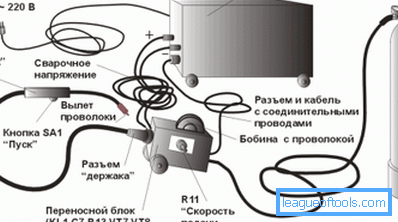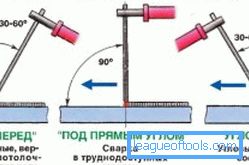How to weld pipes by electric welding correctly
Welding works are of great importance in various industries, as well as during repairs and construction. Welding has been used for several decades.

Scheme of the device of the welding machine.
There are several types of it: manual electric arc, gas, semi-automatic and with the help of an automatic machine. Through it, you can connect various configurations and sizes of parts. Often you have to weld pipes. Not everyone knows how to weld electric pipes. The technology itself has its own characteristics.
This is due, primarily, to the location of the welded surface. Despite this, welders love to connect pipes together, because it is relatively easy and cheap. An interesting fact is that when welding pipes are used different types of connections. Pipes can be interconnected by an overlap, butt or with an angle joint.
Depending on the spatial location of the weld, the joint may be vertical, horizontal or ceiling type. It is important that the weld be formed on the outer surface of the pipe, inside or immediately on both. Let us consider in more detail the main stages of the work on welding the pipeline.
Preparatory stage
In order to properly weld the pipes, it is necessary to prepare the workplace and equipment. Electric welding machines are different. Allocate stationary, mobile and portable units. If until recently old transformers with a rectifier with direct current were used, today inverters are increasingly used. This is more compact equipment.
When buying, you need to pay attention to the operating voltage. There are devices operating at 220, 380 V, as well as a universal type. It is important that the pipes can be welded by manual arc welding with conventional electrodes, as well as those that do not melt in a protective gas or by using a semiautomatic device.

Electrode classification.
The second step is the choice of electrodes. It is desirable that they coincide with the type of metal from which the pipes are made. Electrodes come in various forms:
- steel;
- copper;
- cast iron;
- brass;
- manganese.
If the pipes are less than 5 mm thick and they are butt-joined, then 3 mm thick electrodes will do. In this case, the current should be approximately 100-200 A. This indicator is used for rotary type of joints. When turning the joints, the preferred current strength is 100-120 A. For thicker pipes, electrodes with a diameter of 4-5 mm are suitable.
The preparatory stage includes checking equipment serviceability. It must be in working condition. It is necessary to cook with electric welding only in protective clothing so that the hot metal does not hit the body. Personal protective equipment is used. These include mittens, mask or shield, shoes, clothing. Immediately before welding the pipes it is necessary to clean them from dirt, debris and fuel and lubricants. To do this, use a brush or cloth.
Back to table of contentsPipeline Welding
How to cook pipes? With the help of electric arc welding, you can form a horizontal or vertical seam. Horizontal runs along the circumference of the pipe, and the vertical - from the side. Often used ceiling and bottom seam. Steel pipes are welded most often in a butt-weld manner. At the same time connect all the edges.

Welding steel pipes.
To properly weld the pipes, it must be remembered that in order to reduce the metal flows in the inside of the pipe, the electrode needs to be placed at an angle of about 45 degrees to the surface. The width of the seam is 6-8 mm, and the height of 2-3 mm. If the pipes are welded overlap, then the height of the seam is somewhat larger.
Of great importance is the fact that in case of uneven edges (deformation of pipes) they are recommended to be leveled. Otherwise, the seam may fail. The connection of small pipes is carried out continuously until the surfaces fully adhere. Initially, it is advisable to grab the metal in several places so that in the process of operation the pipes do not move.
When welding the pipeline can not apply the lining rings. The number of layers is determined by the thickness of the pipe. If it is less than 6 mm, then 2 or 3 layers will be required. If more than 19 mm, then welding is carried out in 4 layers. Each layer is immediately cleared of slag, only then the second and all subsequent layers are made.
Back to table of contentsWelding vertical seams
Very often the pipes are arranged in such a way that they have to be connected using a vertical seam. To ignite an electric arc, you need to touch the surface of a metal pipe with an electrode. It is necessary to make a small gap between the edges of the pipes.

Electrode positions during welding.
During operation, the electrode will melt, so you need to bring it a little closer to the product. In the event that it sticks, you need to shake it a little aside. Adhesion of the electrode may indicate low electrical current. For your own safety, it is not necessary to direct the holder with the electrode towards you.
Not everyone knows how to weld pipes with a vertical seam. The main difference from other methods of pipe welding is that the connection is made from bottom to top. It does not need to lead the electrode too quickly, it is recommended to form each drop after the previous one. This is the only way to get a smooth and high-quality weld. The gap must be completely filled with molten metal.
It must be remembered that pipes having a small diameter are welded in a continuous manner, and large ones are intermittent.
At the end of the work, the seam is cleared of scale and slag. A thorough visual inspection of the seam for any defects.
Back to table of contentsList of tools and materials

The scheme of welding galvanized pipes.
In order to properly weld pipes by electric welding, it is necessary to have special equipment and tools available. The welder must have a welding machine, personal protective equipment (gloves, clothing, shoes, mask or shield), a metal brush, chisel, hammer, rags. In addition, a current source and the required number of electrodes will be required. When connecting the current must be observed polarity.
Thus, any welder, even inexperienced, can weld pipes. It is important to know all aspects of the work. The structural strength and quality of the weld is largely determined by the mode of operation of the equipment. It is important to correctly set the amperage. It depends on the thickness of the pipes and the diameter of the electrodes.
When connecting pipes to each other, it is best to use a transverse arc path. When it moves the electrode with the help of oscillations in one direction or the other. In some cases, it is necessary to weld square-shaped pipes. In this situation, it is required to fasten both ends so that they do not shift relative to each other. If you follow all the described rules, you can achieve the perfect result, and the pipes will last for many years.